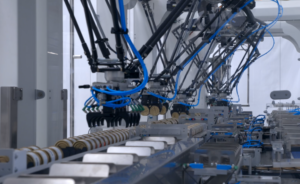Gripper technology overcomes bottleneck to boost efficiency and uptime

When a major global petfood company was facing downtime issues relating to its labelling system, it asked its packaging machinery supplier to devise a solution that would overcome the problem.
The packaging company turned to Gimatic and the line is now back up to full speed.
A leading global pet food manufacturer was facing significant downtime issues relating to incorrect application of labels on its small cans of petfood.
The issue became apparent when the cans entered the end-of-line packaging machines, designed and installed by Cama Group. So Cama approached Gimatic to devise an robot end-effector that would be more tolerant to the downstream issues.
The line Cama Group designed and installed comprised a cartoner with integrated loading unit and a case packer. In operation the loading unit receives four flavours of canned petfood, each fed from separate lines. Four robots are used to phase each flavour and prepare each cartons collation, where the cans are picked in pairs and placed on edge before being sideloaded into a pre-formed carton travelling on a parallel conveyor.

The completed packs – which can contain either four or eight cans, depending on the batch instructions – then enter a spiral conveyor, before being coded and weighed. They then enter a horizontal case packer, where they are loaded into pre-glued RSC cases, with the configuration and product count varying depending on the end customer requirements.
According to Fabio Melli, sales engineering manager at Cama: “Before the cans come into the packing line, they pass through a labelling station, which sees labels applied around the full 360 circumference of the can. But the process was not 100 per cent effective. Sometimes cans would appear without labels, but still covered in the glue, and this created an issue by gumming up the vacuum heads used by the robots. If a good vacuum is not formed, the can will either remain in the feed, or will be picked and then dropped, something which stops production, as the blockage is cleared and the vacuum head cleaned. At the speed and throughput our machines operate, down time of even just a few minutes is considerable.”
Upon investigating the problem and looking at potential remedies, engineers at Cama tasked Gimatic with the development of an alternative solution that would address the glue problem.

According to Federico Tona, Country Sales Manager at Gimatic: “After examining the issue, it was clear that a vacuum-based pick up system was no longer feasible, so we suggested the deployment of one of our standard pneumatic gripper solutions, but with fingers developed specifically for this application. These fingers were also designed in such a way that only one set would be needed for the two different can types.
“In addition to addressing the problem of incomplete labels,” Tona continues, “Cama’s customer was also conscious of the high levels of compressed air being consumed by the vacuum system. Our gripper solution provided the perfect answer to this too, as its consumption is far lower.
“Although the gripper heads come at a slightly higher price point,” he adds, “the small additional cost is almost immediately offset by the lower energy consumption, coupled to the significant drop in downtime related to incorrectly labelled cans.
Our grippers are also guaranteed for 10 million cycles, so it is clear to see where the payback calculations stem from and, of course, the additional ROI and OEE attached to such a long and productive service life.”
The polyethylene grippers from Gimatic have a special interior-face surface treatment, which prevents the glue from fouling the primary surfaces. The gripper heads also incorporate innovative three-variable, single-wire sensors that detect the presence of cans, meaning that downtime and machine damage are kept to a minimum.

Tona concludes: “We tested multiple options and undertook a number of experimental production runs before we confirmed the best solution. The end customer has verified that the new approach is working as expected and is helping to maintain maximum possible uptime. It is also looking to roll out this gripper-based solution to other machines – both those already installed and those still on the drawing board.”
Melli backs this up: “Our customer is delighted with the solution and has told us that production is far more consistent and throughput more even, indeed uptime-based efficiency has risen significantly.”
He concludes: “Our machines are designed to deliver the best possible performance for a variety of markets, and with the support of suppliers like Gimatic, we can be confident that we will always have highly effective answer to our customers most pressing problems.”




